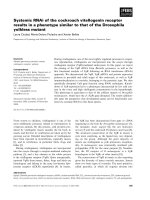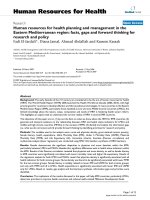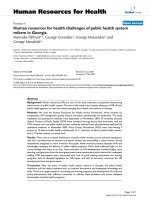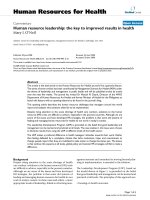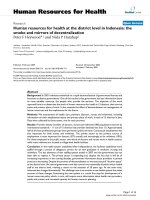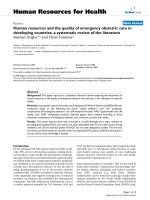báo cáo sinh học:" Human resource leadership: the key to improved results in health" pptx
Bạn đang xem bản rút gọn của tài liệu. Xem và tải ngay bản đầy đủ của tài liệu tại đây (243.02 KB, 4 trang )
BioMed Central
Page 1 of 4
(page number not for citation purposes)
Human Resources for Health
Open Access
Commentary
Human resource leadership: the key to improved results in health
Mary L O'Neil
Address: Center for Leadership and Management, Management Sciences for Health, Cambridge, MA, USA
Email: Mary L O'Neil -
Abstract
This article is the lead article in the Human Resources for Health journal's first quarterly feature.
The series of seven articles has been contributed by Management Sciences for Health (MSH) under
the theme of leadership and management in public health and will be published article by article
over the next few weeks. The journal has invited Dr Manuel M. Dayrit, Director of the WHO
Department of Human Resources for Health and former Minister of Health for the Philippines to
launch the feature with an opening editorial to be found in the journal's blog.
This opening article describes the human resource challenges that managers around the world
report and analyses why solutions often fail to be implemented.
Despite rising attention to the acute shortage of health care workers, solutions to the human
resource (HR) crisis are difficult to achieve, especially in the poorest countries. Although we are
aware of the issues and have developed HR strategies, the problem is that some old systems of
leading and managing human resources for health do not work in today's context.
The Leadership Development Program (LDP) is grounded on the belief that good leadership and
management can be learned and practiced at all levels. The case studies in this issue were chosen
to illustrate results from using the LDP at different levels of the health sector.
The LDP makes a profound difference in health managers' attitudes towards their work. Rather
than feeling defeated by a workplace climate that lacks motivation, hope, and commitment to
change, people report that they are mobilized to take action to change the status quo. The lesson
is that without this capacity at all levels, global policy and national HR strategies will fail to make a
difference.
Background
Despite rising attention to the acute shortage of health
care workers, solutions to the human resource (HR) crisis
are difficult to achieve, especially in the poorest countries.
Although we are aware of the issues and have developed
HR strategies, the problem is that some old systems of
leading and managing human resources for health do not
work in today's context. In these cases and others, a more
appropriate mode of leadership, linked to reforming man-
agement systems and committed to moving beyond plan-
ning to implementation, is essential to the solution.
The Leadership Development Program (LDP), based on
the model shown in Figure 1, is grounded on the belief
that good leadership and management can be learned and
practiced at all levels. The principles of this approach are:
▪ focusing on health outcomes
Published: 20 June 2008
Human Resources for Health 2008, 6:10 doi:10.1186/1478-4491-6-10
Received: 24 April 2008
Accepted: 20 June 2008
This article is available from: />© 2008 O'Neil; licensee BioMed Central Ltd.
This is an Open Access article distributed under the terms of the Creative Commons Attribution License ( />),
which permits unrestricted use, distribution, and reproduction in any medium, provided the original work is properly cited.
Human Resources for Health 2008, 6:10 />Page 2 of 4
(page number not for citation purposes)
▪ working in teams to solve problems
▪ applying leadership practices to real challenges
▪ creating a climate that encourages change
▪ sustaining change by grounding solutions in manage-
ment systems.
The case studies in this issue were chosen to illustrate
results from using the LDP at different levels of the health
sector:
▪ Central level: emergency hiring program in Kenya.
▪ Local level: empowering workers in Mozambique.
▪ Civil society: improving retention and performance in
Uganda.
The format of the LDP has been adapted, for example, to
accommodate people from rural areas. The program has
been translated into French, Spanish, Portuguese, and
Arabic. One important finding is that participants often
replicate the principles in many areas of their work and
teach them to others.
The LDP makes a profound difference in health managers'
attitudes toward their work. Rather than feeling defeated
by a workplace climate that lacks motivation, hope, and
commitment to change, people report that they are mobi-
lized to take action to change the status quo. The lesson is
that without this capacity at all levels, global policy and
national HR strategies will fail to make a difference.
Discussion
The dimensions of the HR crisis in health have been
reported in stark terms in publications and studies for
years by the Joint Learning Initiative [1], the World Health
Organization (WHO) [2], and others [3]. With the forma-
tion of the Global Health Workforce Alliance and the
commitment of organizations such as the WHO, we now
have mechanisms to provide leadership at the global
level. But strategic HR leadership (managing people as a
strategic resource) poses a significant challenge for most
ministries of health because HR management policies and
practices are not in professional hands. Governments lack
the ability to adapt to rapid changes such as labor migra-
tion, the impact of HIV/AIDS, structural adjustments and
hiring freezes. Countries need visionary leaders to advo-
cate that funding for HR solutions go hand-in-hand with
funding for health programs. Millions of dollars, for
example, have been invested to ensure the availability of
AIDS and tuberculosis drugs, but hardly any funding has
been committed to ensure that there is a sustainable work-
force to administer these drugs.
At all levels of the health system, what is lacking is a criti-
cal mass of proactive and respected HR managers and spe-
cialists who are professionally qualified and have the
authority and clout to attract attention and deal with these
challenges and champion a comprehensive response. To
make significant improvements in human resources for
health and in the health of populations – improvements
that will last – managers need to know how to lead and
how to influence HR changes within and outside their
organizations.
Leading and managing results model – how do management and leadership contribute to improved service delivery?Figure 1
Leading and managing results model – how do management and leadership contribute to improved service delivery?
Human Resources for Health 2008, 6:10 />Page 3 of 4
(page number not for citation purposes)
Human resource challenges reported by leaders and
managers
Health leaders and managers report that they are mired in
layers of civil service rules, highly centralized and frag-
mented HR management systems, poor incentives, under-
use or misuse of existing staff, and external pressure to
diminish social-sector expenditure. Managers in many
countries say that the leadership to address these issues is
lacking. There are pilot projects and examples of effective
HR solutions at the country level, but HR directors and
policymakers need a new way of thinking about leading
and managing to sustain these positive results and scale
them up. Health managers at a recent HR leadership meet-
ing in Southern Africa described their problems as fol-
lows: "We are certainly weakest at implementing. We
agree on weekly, monthly, and quarterly activities – but at
the end of the day almost nothing gets done "
These sentiments are echoed around the world. Most
countries have clearly identified the HR challenges they
face and many have developed an HR strategy, but these
often stay on the shelf and are not implemented in any
systematic way that will achieve their intended outcomes.
Often the reason cited for this failure is lack of funding,
but we propose that, even with adequate funding, efforts
to implement HR plans and obtain results may fail due to
other factors.
Factors that contribute to the failed implementation of
human resource strategies
▪
Fragmentation of effort
Donors fund pieces of the solution, with little harmoniza-
tion among these partial approaches, diminishing the
impact that could result from a comprehensive, harmo-
nized approach.
▪
Unrealistic time frames
HR solutions require time (at least three to five years) to
produce results.
▪
No grounding in management systems
HR interventions are often not grounded in any sustaina-
ble HR management (HRM) system. HRM systems are
fragmented, with authority for HR planning, recruitment,
hiring, deployment, promotion, compensation, incen-
tives, and staff development spread among several minis-
tries. These systems need to be streamlined and staffed by
trained HR professionals before lasting change can occur.
▪
Key stakeholders, especially outside the health sector, are not
involved
Ministries of health cannot solve the HR crisis on their
own. Ministries of civil service, finance, and education,
and the private sector all have a role to play.
Progress in dealing with these factors depends on manag-
ers who are able to lead and inspire teams at all levels of
the health system to transform strategies, plans, and rec-
ommendations into a comprehensive and harmonized
approach. At present, most government HR functions are
handled by personnel administrators who were trained to
handle routine civil service policies and procedures. There
is an urgent need to professionalize this cadre, expand the
organizational view of their roles, and update their skills
so they can be more effective in leading change and imple-
menting plans.
This is not the traditional approach to developing leader-
ship, which is aimed at top leaders and focuses on leader-
ship traits and characteristics. This model focuses on
developing teams that can identify problems, find solu-
tions, and get results (see Figure 1).
Case studies in applying leadership practices
The three articles that follow in this series constituting the
special quarterly feature on leadership illustrate what can
happen when managers put the MSH model into practice.
We offer examples of HR activities carried out in the pub-
lic sector at both the central and district levels, as well as
an example from civil society.
Conclusion
The dialogue about human resources for health today is
broad. It offers data on the shortages of health workers
and the human toll that results, it provides a detailed anal-
ysis of the causes of the crisis, and it presents a wide range
of solutions from task-shifting to new models for commu-
nity nursing. It asks tough questions about whether Inter-
national Monetary Fund policies constrain health
spending in poor countries, about the consequences of a
health strategy that is built around a 50% focus on HIV/
AIDS, and about the responsibility of wealthy countries
recruiting needed health staff from the poorest countries
in the world. The dialogue is also asking questions about
the best way to move from awareness and analysis to
action. The answers to this question are many and depend
on the situation of each country and its strengths and
weaknesses.
One imperative for all countries, however, is the leader-
ship and management capability to translate HR strategies
into systems and practices that result in sustainable
improvements. At the beginning of this piece, HR manag-
ers who were uninspired concerning their ability to bring
about these kinds of positive changes were cited. HR man-
agers who participated in a Leadership Development Pro-
gram noted a profound difference: "We had discussed the
challenges before, but the leadership program actually got
us mobilized to complete it."
Publish with Bio Med Central and every
scientist can read your work free of charge
"BioMed Central will be the most significant development for
disseminating the results of biomedical research in our lifetime."
Sir Paul Nurse, Cancer Research UK
Your research papers will be:
available free of charge to the entire biomedical community
peer reviewed and published immediately upon acceptance
cited in PubMed and archived on PubMed Central
yours — you keep the copyright
Submit your manuscript here:
/>BioMedcentral
Human Resources for Health 2008, 6:10 />Page 4 of 4
(page number not for citation purposes)
The conclusion? The complex conditions under which we
work to address the HR crisis demand a new style of lead-
ership that encourages innovation and teamwork and a
more professional approach to HR management. At all
levels we need committed leaders and qualified HR man-
agers to translate country-level strategies and global
frameworks for migration, financing options, and fast-
tracking of education and HR reform into solutions on the
ground.
Competing interests
The author declares that she has no competing interests.
Authors' contributions
Dr MO researched and wrote this article and read and
approved the final manuscript.
Acknowledgements
None
References
1. Joint Learning Initiative: Human resources for health: overcom-
ing the crisis. Cambridge MA, Global Equity Initiative; 2004.
2. World Health Organization: Working together for health.
Geneva 2006.
3. Management Sciences for Health: Tackling the crisis in human
resources for health. The Manager 2004.
